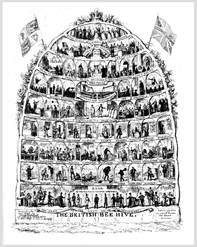 The British Beehive (an enlarged section of which forms the above banner) was originally designed by book illustrator and caricaturist George Cruikshank in 1840, and then etched by him in 1867. The Beehive shows nine layers of society with the Bank of England and armed forces as the bedrock, and Queen Victoria and the royal family at the top. Altogether there are 54 cells showing the various classes and trades. The British Beehive cartoon presented a satirical, but fairly accurate, picture of British life with the male worker bees confined to their cells or labours supporting the colony (feeding the Queen and the upper classes). In the "Public Opinion" of 1867 (which was a weekly review of current thought and activity in the press) it reported the object of the etching was to show the perfection of the country and that "we can do without Parliamentary Reform." At the time the second Reform Act was going through Parliament. Since 2018 is the centenary of the Suffragette Movement, it's worth pointing out there are very few women in the picture - just four cells showing dairymaids, drapers and miscellaneous female occupations – and they are way down at levels five and six. Ignoring the Queen, it’s very much a male dominated world which is probably no surprise to anyone, given that this was the 19th century.
2 Comments
Raymond Fowler
8/25/2020 04:17:52 am
I studied Chartism for some time in the 80s and 90s, working with Dr Dorothy Thompson. I no longer have any need for all the books and material I have. I would be delighted to donate them to anyone studying the subject. Please contact me.
Reply
Margaret Chase
8/25/2020 06:59:18 am
Hi Richard, Thanks for contacting me regarding John Collins materials. I will email you privately. Regards Margaret Chase
Reply
Leave a Reply. |
Chartist BlogWelcome to the John Collins Chartist website. My name is Margaret Chase, and this blogspot is a place for me to share snippets of information and anything else relevant to the life and times of John Collins and the Chartist Era. For more about John Collins and the Chartist Movement please go to the menu bar at the top of this page or start off on the Welcome Page. ArchivesCategories |
 RSS Feed
RSS Feed